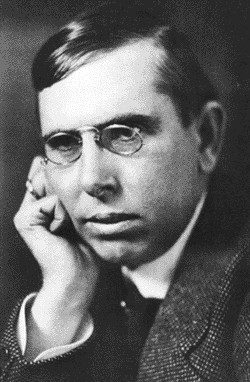

Of the many Hoosiers throughout the years who have succumbed to the temptation to put pen to paper in an imaginative way, none is as important to American literature as Theodore Dreiser. Never as popular in his lifetime as contemporaries Booth Tarkington or Meredith Nicholson, Dreiser and his works are now sources of an ever-increasing amount of textual, critical, and biographical scholarship. A small collection of Dreiser papers in the IHS library sheds a faint but colorful light on the author's life and reputation.
Born in Terre Haute in 1871 the second youngest in a large family that would number ten children, Dreiser grew up in various Indiana cities, including Sullivan, Vincennes, Evansville, and Warsaw, the family looking always for a place that would supply them with something more than mere subsistence. In A Hoosier Holiday (1916) Dreiser referred to these formative years as "one unbroken stretch of privation and misery." From his Indiana years Dreiser derived what would become a major theme of his subsequent writing: the effect of money or the lack of it on moral behavior. He founded his best works, Sister Carrie (1900), Jennie Gerhardt (1911), and An American Tragedy (1925), solidly on memories of his Indiana years.
Dreiser's genius was not immediately recognized by the American reading public. Sister Carrie sold only 450 copies in its first year and would not find its true audience for another twenty years. By the mid-1920s, with the appearance of An American Tragedy, Dreiser was celebrated as one of America's most engaging and original writers. Hoosiers, however, were generally not a part of the celebration.
The Society's collection of Dreiser material contains miscellanea from 1935 to 1937, including the author's 102-page, typed address book, with handwritten revisions by Dreiser, and letters pertaining to investments, lawsuits, and a book burning. An excerpt from one of the latter, written by newspaper editor Charles Yost of Fayette, Ohio, provides an indication of Dreiser's stature in his home state at this time.
In a letter of 2 May 1935 Yost described his encounter with the Indiana Book Review Club of Angola, Indiana:
It was guest night or day rather for this club and the librarian of the Carnegie library there was invited to be present and expected to until she was told by Mrs. Emerson that I would probably have something to say about Mr. Dreiser. . . .
Well, after I had concluded my remarks Mrs. Emerson told me the lady librarian said she didn't have the nerve to meet me and therefore had not put in her appearance. She said that the library trustees had ordered her to collect and burn every one of Theodore Dreiser's books. I almost burned up with a fever and wanted to know why she (Mrs. Emerson) had not told me that before I began to speak. Had I known that they would have got a rap that would have made them stagger for weeks. . . . What sort of people are the trustees? Can't you imagine? I did say, however, that teachers in our schools were not familiar with the best contemporary authors; that libraries in many places were somewhat leery of Dreiser, Nathan, Mencken, Darrow, Lewis, and Wells, and I imagine that went home, although I didn't know that you were on the expurgatorious list and your books had been burned. I imagine they would likewise burn you at the stake if they dared.
Dreiser's acceptance in his home state was a long time in coming. Even by 1962, when the IHS published Arthur Shoemaker's A History of Indiana Literature, Dreiser was not treated "because of insufficient residence and Indiana influence in [his] works." Though he left the state for good at the age of nineteen, he carried his experiences of poverty and social inferiority with him for the rest of his life, utilizing them repeatedly as subjects for his enduring art.
 Return to IHS home page, Golden Age or Hoosier Heritage.
Return to IHS home page, Golden Age or Hoosier Heritage.